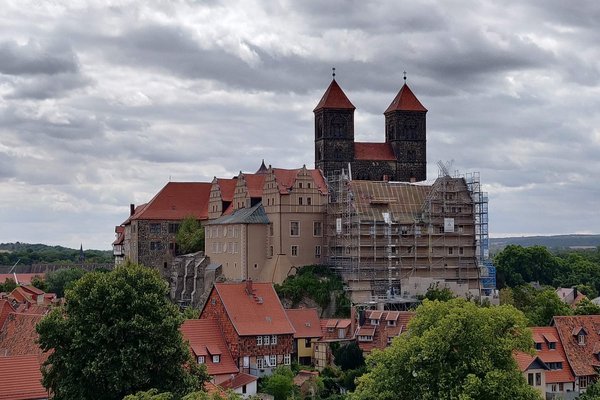Germany
Quedlinburg
The Collegiate Church, Castle and Old Town of Quedlinburg comprise a medieval townscape with a large number of high-quality timber-framed buildings.
Quedlinburg has been a prosperous trading town since the Middle Ages. Its architectural richness is connected to the Saxonian-Ottonian dynasty of the first German state, for whom this was their capital. Its layout is typical for a medieval town, having started as a castle village and later incorporating other neighbourhoods. The timber-framed houses mainly date from an economic boom between 1620 and 1720.
Community Perspective: The market square, with the Roland statue, and the Church of St. Servatius are its highlights.
Site Info
Official Information
- Full Name
- Collegiate Church, Castle, and old Town of Quedlinburg (ID: 535)
- Country
- Germany
- Status
-
Inscribed 1994
Site history
History of Quedlinburg
- 1994: Inscribed
- Inscribed
- 1990: Deferred
- Inscribed area to be better defined and which?
- Type
- Cultural
- Criteria
- iv
Links
- UNESCO
- whc.unesco.org
- Official
-
- quedlinburg.de — Weltkulturerbe Quedlinburg
All Links
UNESCO.org
- whc.unesco.org — whc.unesco.org/
Official Website
- quedlinburg.de — Weltkulturerbe Quedlinburg
News Article
- April 14, 2011 monstersandcritics.com — Fire damages part of German UNESCO heritage town Quedlinburg
Community Information
- Community Category
- Urban landscape: Medieval European
Travel Information
Harz Hotspot
Recent Connections
-
Libraries
Historische Bibliothek QuedlinburgSee d…
-
Harz Hotspot
The train journey time between Goslar a… -
Built in the 14th century
The two towns were merged in 1330 and w…
Connections of Quedlinburg
- Geography
- Trivia
-
-
Modern Board Games
Die Quacksalber von Quedlinburg (2018)
-
- History
-
-
Located in a Former Capital
Quedlinburg is dubbed as Germany's First Capital, having been the place where Heinrich der Vogler (Henry the Fowler) was offered the German crown in 919 by Franconian nobles. Henry's son, Otto I (Otto the Great) became king of the Holy Roman Empire. -
Holy Roman Empire
in 919, Quedlinburg became the first capital of the Saxonian-Ottonian dynasty of the Holy Roman Empire -
Hanseatic League
"The town became a member of the Hanseatic League in 1426. Quedlinburg Abbey frequently disputed the independence of the town, which sought the aid of the Bishopric of Halberstadt. In 1477, Abbess Hedwig, aided by her brothers Ernest and Albert, broke the resistance of the town and expelled the bishop's forces. Quedlinburg was forced to leave the Hanseatic League and was subsequently protected by the Electorate of Saxony. " (wiki)
-
- Architecture
-
-
Timber framing
many buildings in the historic town -
Pre-Romanesque
St. Wiperti, St. Marien -
Renaissance
City CastleSee de.wikipedia.org
-
Vernacular architecture
"The importance of the town rests on three main elements: the preservation of the medieval street pattern, the wealth of urban vernacular buildings, especially timber-framed houses of the 16th and 17th centuries, and the important Romanesque collegiate church of St Servatius." (AB Ev) -
Art Nouveau
The town also has a number of interesting Art Nouveau buildings from the late 19th century. -
Gothic
Town HallSee de.wikipedia.org
-
Baroque
The three-story half-timbered house "Börse" was built by master carpenter Andreas Besen in the Baroque style. An inscription cites its year of construction as 1683.See de.wikipedia.org
-
Romanesque
"The Collegiate Church of St Servatius is one of the masterpieces of Romanesque architecture." (Official description) "The castle, church and old town (...) were added to the UNESCO World Heritage List in 1994 because of their exceptional preservation and outstanding Romanesque architecture." (wiki)
-
- Damaged
- World Heritage Process
-
-
Inscribed on a single criterion only
iv. to be an outstanding example of a type of building, architectural or technological ensemble or landscape which illustrates (a) significant stage(s) in human history -
Extended from original TWHS
Site on GDR's Tentative List only included Burgberg and Stiftkirche
-
- Religion and Belief
-
-
Jewish religion and culture
See de.wikipedia.org
-
Religious Relics
One of Mary's hair is kept at Quedlinburg Abbey. -
Nunneries
St. Mary Convent -
Benedictines
St. Mary Convent -
Augustinian Order
AugustinerklosterSee de.wikipedia.org
-
Premonstratensians
In 1146, the St. Wiperti Monastery was converted into a Premonstratensian monastery. (Wikipedia)See de.wikipedia.org
-
Protestantism
Quedlinburg Abbey and the female secular monastery became protestant in 1539. All other churches followed.
-
- Human Activity
-
-
Breweries
Brauhaus Lüdde -
New Towns
"Around the year 1,200, the Quedlinburg New Town began to develop along the walls of the Old Town behind the Mühlgraben canal. Its inhabitants came from the villages surrounding Quedlinburg" -
Transromanica
Collegiate Church of St. Servatius
-
- Constructions
-
-
Roland statue
Dating from ca. 1460, restored in 1869 -
Historic Pharmacies
Adler- und RatsapothekeSee de.wikipedia.org
-
Notable Hotels
Zur Goldenen SonneSee de.wikipedia.org
-
Mausolea
Goetze MausoleumSee de.wikipedia.org
-
- Timeline
-
-
Built in the 14th century
The two towns were merged in 1330 and were surrounded by a common city wall. (AB ev)
-
- WHS Hotspots
-
-
Harz Hotspot
The train journey time between Goslar and Quedlinburg is around 1h 18m and covers a distance of around 79 km. (Rome2rio)
-
- Science and Technology
-
-
Libraries
Historische Bibliothek QuedlinburgSee de.wikipedia.org
-
News
- monstersandcritics.com 04/14/2011
- Fire damages part of German UNESCO…
Recent Visitors
Visitors of Quedlinburg
- Adrian Turtschi
- aj
- Alexander Barabanov
- Alexander Lehmann
- A. Mehmet Haksever
- Ammon Watkins
- Ana Lozano
- Argo
- ArnaudFilloux
- AS
- Aspasia
- Assif
- a.thum
- Atila Ege
- Aunti
- awestix
- Bamse
- basementonline
- BaziFettehenne
- Bill Maurmann
- Bin
- Birgitte Sørensen
- Bram de Bruin
- brendairala
- Brendan Carroll
- Bropyk
- Carlos Sotelo
- Caspar
- Cezar Grozavu
- CherylKla
- Christer Sundberg
- Christian Wagner
- christof
- Christoph
- Christravelblog
- Claire Bradshaw
- ClaraHH
- Cluckily
- Clyde
- Colossus
- Corinne Vail
- Csaba Nováczky
- ctravel
- CugelVance
- Dani Cyr
- Daniela Hohmann
- Daniel Chazad
- Dimitar Krastev
- Dimitrios Polychronopoulos
- Dirk-pieter
- Dolemite92
- Dorejd
- Dr. Caligari
- Echwel
- Elia Vettorato
- Ellen Nielsen
- Els Slots
- Emilia
- erdsaumnaht
- Erik Jelinek
- Errol Neo
- Eva Kisgyorgy
- Evgenii
- Fam39
- Fan Yibo
- Farinelli
- Federico P.
- Feldhase
- Femke Roos
- FK
- Frederik Dawson
- FS
- Galgalula
- Garrett
- Gary Arndt
- George Gdanski
- GeorgeIng61
- GerhardM
- Harald T.
- Harry Mitsidis
- heywhatever2
- Hubert
- Iain Jackson
- Ian Cade
- Ingemar Eriksson
- Ivan Rucek
- Jacob Otten
- Jakob F.
- Janina Lehmann
- janis
- Janos
- Jan-Willem
- Jan Zimmermann
- Jarek Pokrzywnicki
- Javier Coro
- Jens
- Jezza
- Joel on the Road
- Jonas Hagung
- Jonas Kremer
- Jonas Martinsson
- Jon Eshuijs
- Joyce van Soest
- Jurre
- Karito Vies
- Kasia M.
- Kbecq
- Ken DJ
- Kerékgyártó
- Kerstin Lange
- Klaus Freisinger
- Knut
- Kristin
- krtek
- kutasp
- Lara Adler
- lichia
- Lisu Marian
- Little Lauren Travels
- Luboang
- Ludvan
- Luis Filipe Gaspar
- Maciej Gil
- Maciej Gowin
- Malgorzata Kopczynska
- Manuelfunk
- marcel staron
- MarcoB_0
- Martin
- Martina Rúčková
- Marty
- Matejicek
- Matthewsharris
- Max
- MaxHeAnouBen
- MaYumin
- MH
- Michaela0705
- MichaelH
- Michael Turtle
- Mikko
- Mikko Syrjä
- Milan Jirasek
- Miloš Tašković
- miri2808
- Mohboh
- Nafis N
- nan
- Nick M
- Nicole Lampos
- Nihal Ege
- opperpco3
- PabloNorte
- Patrik
- Paul Schofield
- peacemaker2142
- PeterH
- Peter Lööv
- Petteri
- Philipp Leu
- Philipp Peterer
- Piotr Wasil
- PlacesWeHaveBeenTo
- Potsdamer
- Purrfect
- Rafał Kałczuga
- Ralf Regele
- Randi Thomsen
- Reisedachs
- Reza
- Rick Ohm
- RobRos
- Roel Sterken
- rogerding
- Roger Ourset
- Roman Bruehwiler
- Roman Raab
- Ronbon
- Rudegirl
- Sabrina Liebehentschel
- Sandmann15
- Schnitzel
- Sebasfhb
- Sehnsuchtsbummler
- Sergio Arjona
- Shandos Cleaver
- Slavi
- Solivagant
- Stanislaw Warwas
- Stijn
- Sturuss
- Svein Elias
- Szucs Tamas
- Tamara Ratz
- Taotao Chen
- Tarquinio_Superbo
- Thomas Buechler
- Thomas van der Walt
- Thorben
- Tom Flaten
- tony0001
- triath
- Tsunami
- Twobaconsandaboston
- usagi1974
- Valentina
- Vanessa Buechler
- VB73
- Veronica
- VLabhard
- WalGra
- Walter
- Wojciech Fedoruk
- Wo_ko
- Xiquinho Silva
- YaroMir
- Yevhen Ivanovych
- Zhenjun Liu
- Zoë Sheng
- Zos M
Community Reviews
Show full reviews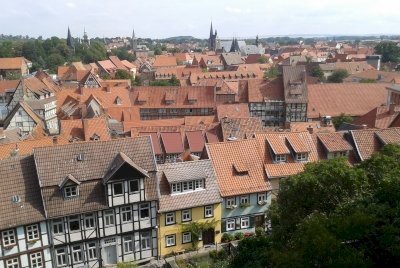
Ten years after my first visit to Quedlinburg, I traveled to Sachsen-Anhalt again in August 2019. I wanted to see not only the town of Quedlinburg but also other interesting places of this part of Germany. During my trip, I explored medieval churches and other structures from middle ages in Naumburg, Merseburg, Halberstadt, Gernrode, Magdeburg, and of course, in Quedlinburg. I must say that the region is stuffed by excellent pieces of architecture and of important history related to a broader area of Central Europe.
It was a pleasure to stroll in the streets of Quedlinburg with more than 1000 “fachwerk” houses. Though this type of houses is quite typical and abundant in central Germany and certain parts of France and England, Quedlinburg is a typical and fine example of its kind that fortunately survived to our days. The inscribed quarters with fachwerk-houses can be found not only in the old and new town, but also in the nearby Munzenberg hill and the part adjacent to the Castle Hill, in the so-called Finkenherd district. If I should compare, I liked historical streets of Goslar a little bit more than those in Quedlinburg. Further, as Goslar without Rammelsberg mines would be very nice but not unique, the same is true for Quedlinburg with respect to its castle hill. Climbing the rock where the castle is located and exploring St Servatius church were my highlights in Quedlinburg. PHOTO – view from the castle hill.
The inscribed area consists also of …
Keep reading 0 comments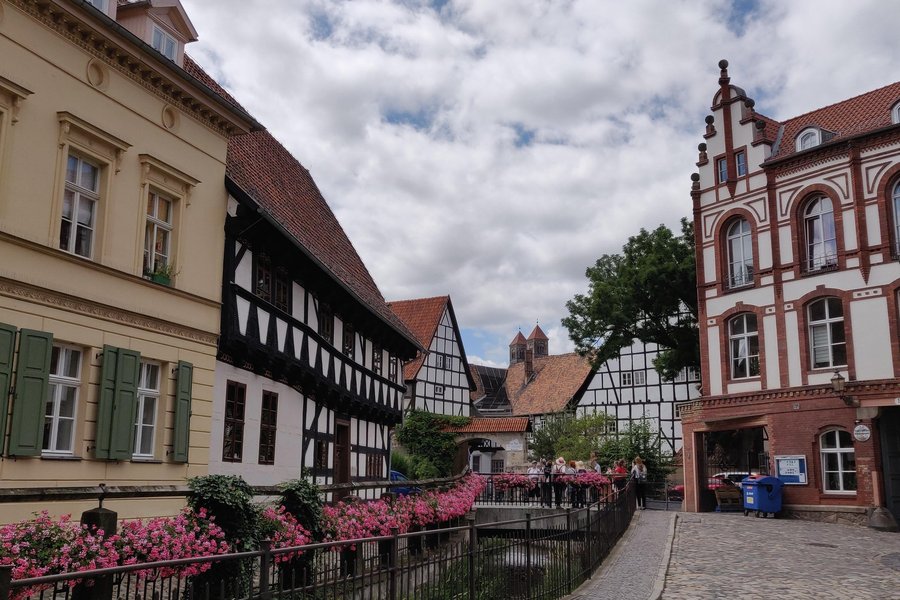
Love Quedlinburg. I find the city and all the old hoses best but outside is layers om buildings from 19th century and of course the magnificent and dramatic location of the cathedral and castle.
Some strange buildings from GDR-zeit still make ugly wounds somewhere but I liked this WHS a lot.
Keep reading 0 comments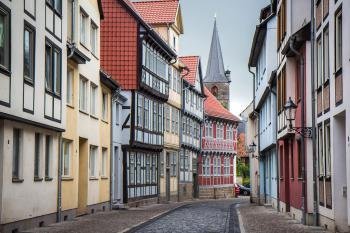
I didn't really have any expectations for Quedlinburg and so was extremely impressed when I finally saw the place. The old town has been preserved so well and the whole area feels like you are actually in a medieval town. The streets are full of beautiful old buildings and the layout (and even some of the shops) are straight out of the middle ages.
Of course, the church at the top of the hill is a must visit but I didn't do too many other 'sights' here - I just enjoyed walking around and getting the atmosphere in the streets.
A lot of the people who visit just come for the day (either on their own or in a tour group). I stayed the night and was really glad I did - the old town is much quieter in the evenings and you can see things and walk around without being amongst crowds of tourists.
Also, if you're leaving by train (as I did), make sure you get a good look at the station - it's very cute!
Keep reading 0 comments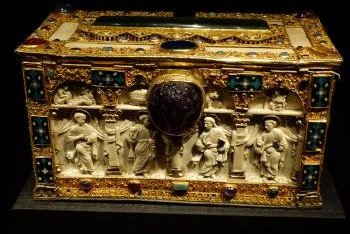
I visited this WHS in November 2014. I really loved this touristy town and the half-timber houses. I'd definitely want to return perhaps during a weekday when it might be less crowded. The highlight of my trip were the treasures inside the imposing Collegiate Church of St. Servatius (picture).
Keep reading 0 comments
Quedlinburg is one of the most historic towns in Germany and experienced its heyday in the 10th to 12th centuries. Walking through the cobble-stoned streets, admiring the countless historic buildings (with the largest collection of half-timbered houses in Germany), and exploring the many hidden corners is quite a pleasant experience. The main feature is the Schlossberg hill with the impressive Church of St. Servatius, where you can admire the Treasury and the interesting Crypt featuring the tombs of King Henry I. and Queen Mathilde. Other interesting buildings include the Renaissance-style Town Hall with the Roland statue in front, and the Romanesque church of St. Wiperti, a short walk away from the centre. Quedlinburg can be easily reached by train in a day trip from Berlin (a change in Magdeburg is usually required).
Keep reading 0 comments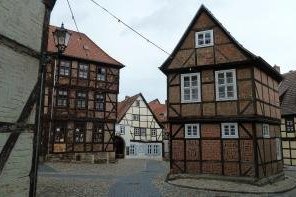
During the day I thought Quedlinburg was rather nice. However an evening stroll started to reveal an even more charming side to the city. The winding streets of half timbered buildings were the real highlight for me, bringing back fond memories of Tallinn.
There were lovely views from the Romanesque colligate church sitting on a hill in the centre of the city. My guidebook was glowing about its interior but I wouldn't say it was particularly remarkable, more just pleasant and simple inside. The castle area was really worthy of a slight climb and Hubert's recommendation for cheesecakes at Café Vincent is a suitable way to relax on the pleasant square next to the castle entrance.
If, like me, you fly into Germany and rely on public transport; Quedlinburg is one of the tougher WHS to get to as it sits at the end of a remote branch line on Germany's wonderful train system. This rather out the way local added to its charm for me. There were a few tourists around but they were mostly domestic, and I feel my German improved immensely through my bumbling conversations over a doily laden breakfast of cold meats and cheese.
I really liked Quedlinburg, it may not have the most astounding monuments however it is a rather fine urban ensemble, and being off the Anglophonic travel trail made this rather enjoyable for me.
[Site 6: Experience 7]
Keep reading 0 comments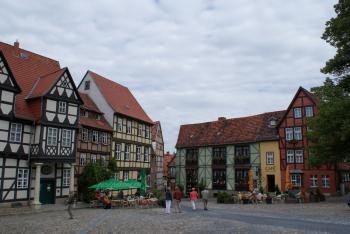
Quedlinburg is a small medieval town with the largest number of half-timbered houses in Germany. There are more than one thousand from six centuries. The town has a nice market square with the town hall and the Roland statue, the WHS includes also the Castle Hill with the Collegiate Church St Servatius, and several other churches. The Romanesque church of St Wiperti with its cemetery reminded me of one of these small enchanting churches in England. The charm of the town is more the preserved medieval townscape and not the extraordinary value of individual buildings. However, I liked Quedlinburg less than other medieval towns in Germany, such as the nearby Goslar or Bamberg. But I can not explain exactly why. My highlights in Quedlinburg are barely related with the WHS: the Lyonel Feininger Gallery and the Café Vincent, where you can taste about 30(!) different homemade cheesecakes.
Keep reading 0 comments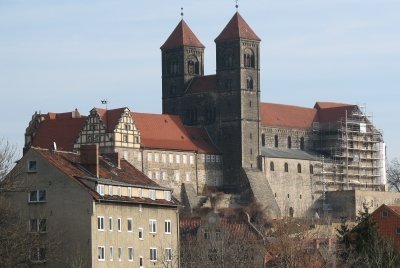
Quedlinburg is not far from Goslar, and at first sight, has a lot in common with this neighbouring WHS (all those colourful buildings with timber frames). I stayed here for two nights in Hotel Zum Bär. This very authentic and well-recommended hotel is situated right in the heart of Quedlinburg’s medieval quarters. My room looked out on the medieval market square, a view that would make many non-Europeans plan a trip immediately.
Probably the best asset of Quedlinburg is its highly original medieval town plan. It all started around the Burgberg, where the administrative center attracted merchants and craftsmen. After that, the old and new towns developed to hold more and more people. When the area inside the city walls became too crowded, new settlements were developed outside the walls. These historical developments can still be easily followed when you walk in Quedlinburg’s streets.
Like the WHS in Bremen, Quedlinburg also has a Roland statue to commemorate its medieval city rights. This one is standing in front of the Rathaus (City Hall) too, and is said to be the second smallest in Germany.
The town is quite pleasant and has a number of things to see and do, however none of those really stand out. A half-day visit was enough for me. Quedlinburg’s value as a tourist destination would benefit from some more signposting and explanation signs I think. But maybe we should be happy that this isn’t a museum town yet. It still has its rough …
Keep reading 0 comments
In August of 2002 I had the unique opportunity to visit Quedlinburg. Unlike other small cities in Western Germany Quedlinburg seemed relatively untouched by modern architecture and surroundings. Not a Mc Donald's in sight!!! It was truly a look at old Germany. The half timbered houses in the center of the city were being restored by Polish artists brought into the area. Great care was given in noting the age of the buildings. Many structures dated back to the 17th century. The city has an abundance of churches and most of them were in the process of being restored and renovated. With only a few hours to visit I was only able to tour one of the churches. The grand pulpit set up at the top of a covered gilded staircase was certainly impressive. While still only partially restored (even after 12 years of re-unification) one could sense the grandeur that it once had.
Tour books about the city were available in various languages. However german was the only spoken language. Not a word of english was heard anywhere which gave it a definite air of authenticity. German tour buses were just beginning to discover this city.
A walk thru the center of the city will reveal secluded cobbled stoned courtyards... a definite fairytale experience. A trip to Quedlinburg would not be complete without a trip to the castle at the top of the hill. A restaurant at the top makes for a good stop. The view from the castle …
Keep reading 0 comments
